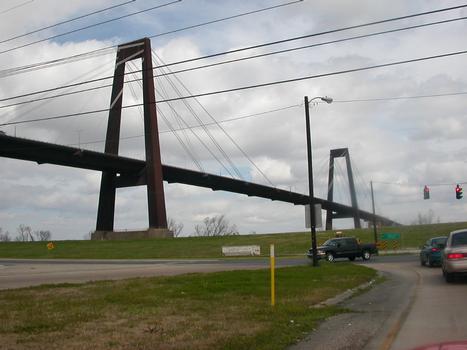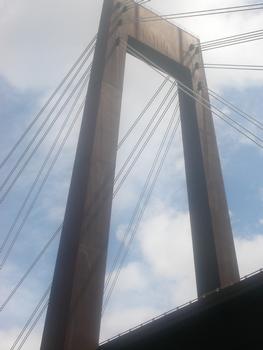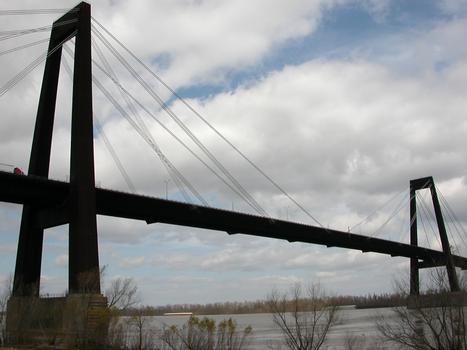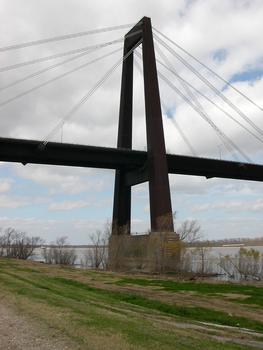General Information
| Other name(s): | Luling-Destrehan Bridge |
|---|---|
| Completion: | 6 October 1983 |
| Status: | in use |
Project Type
| Structure: |
Cable-stayed bridge with fan system Three-span cable-stayed bridge |
|---|---|
| Support conditions: |
for registered users |
| Secondary structure(s): |
Structurae Plus/Pro - Subscribe Now! Structurae Plus/Pro - Subscribe Now! |
| Function / usage: |
Motorway bridge / freeway bridge |
| Material: |
Weathering steel bridge Structurae Plus/Pro - Subscribe Now! Structurae Plus/Pro - Subscribe Now! |
| Plan view: |
Structurae Plus/Pro - Subscribe Now! |
Awards and Distinctions
| 1984 |
award winner
for registered users |
|---|
Location
| Location: |
Destrehan, Saint Charles Parish, Louisiana, USA Luling, Saint Charles Parish, Louisiana, USA |
|---|---|
| Address: | I-310 |
| Crosses: |
|
| Coordinates: | 29° 56' 33" N 90° 22' 27" W |
Technical Information
Dimensions
| total length | 3 261 m | |
| main bridge | ||
|---|---|---|
| main span | 372.5 m | |
| total length | 678.6 m | |
| deck | deck depth | 4.27 m |
| deck width | 25.1 m | |
| pylons | height | 122 m |
Cost
| cost of construction | United States dollar 135 000 000 |
Materials
| deck |
weathering steel
|
|---|---|
| piers |
reinforced concrete
|
| pylons |
weathering steel
|
Chronology
| 7 May 1983 | Completion. |
|---|
Excerpt from Wikipedia
The Hale Boggs Memorial Bridge (also known as the Luling–Destrehan Bridge) is a cable-stayed bridge over the Mississippi River in St. Charles Parish, Louisiana. It is named for the late United States Congressman Hale Boggs. The bridge was dedicated by Governor David C. Treen and Bishop Stanley Ott of Baton Rouge and opened to traffic on October 8, 1983 connecting Louisiana Highway 18 on the West Bank and Louisiana Highway 48 on the East Bank. The Hale Boggs Bridge was the third major cable-stayed bridge in the United States after the 1,255-foot John O'Connell Bridge of Sitka, Alaska (the United States' first vehicular cable-stayed girder spanned bridge) and the Pasco-Kennewick Bridge or Ed Hendler Bridge in Washington.
In 1993, the Hale Boggs Bridge was incorporated into the newly completed Interstate 310 and was the first cable-stayed bridge to be added to the interstate highway system. Upon completion of Interstate 49, I-310 and the Hale Boggs Bridge will serve as a connection between I-49 and Interstate 10 on the western edge of metropolitan New Orleans.
Design
The superstructure and West approaches of the Hale Boggs Bridge were designed by the prime consultant, Frankland and Leinhard of New York, NY (E. Stanley Jarosz, Vice-president & Chief Engineer, & Myron Lepkaluk, President). The James F. Lincoln Arc Welding Foundation recognized Jarosz's and Frankland & Leinhard's design achievement with a major award in the year the bridge was completed. The foundations of the main span and the East approaches were designed by Modjeski and Masters of Harrisburg, PA. Original construction was by a team headed by Williams Brothers Construction Co, Inc.
The Hale Boggs's design features unpainted weathering steel towers and superstructure, an orthotropic steel box girder superstructure, and two planes of cables in a fan pattern. Weathering steel exhibits uniform oxidation or "rusting" that results in a uniform protective patina and reduces maintenance requirements. The bridge's weathered bronze color is intended to blend with the muddy waters of the Mississippi River.
The prefabricated cables, the Swiss manufacturer of which was selected by Williams Brothers Construction Co., Inc. featured a heavy polyethylene sheathing that began cracking even before installation, leading to moisture intrusion and cable deterioration. There were additional problems with rust and water leakage in the anchorages. A project to replace the cables began in summer 2009.
MV George Prince Gerry disaster
The bridge was under construction on October 20, 1976 when the Luling–Destrehan Ferry, George Prince, was struck by a tanker while crossing the river from Destrehan to Luling; the same communities connected by this bridge. Seventy-eight people perished when the ferry capsized; only eighteen survived. There is a memorial on the East Bank in Destrehan to honor all the people who died in the disaster.
Text imported from Wikipedia article "Hale Boggs Memorial Bridge" and modified on 22 July 2019 under the CC-BY-SA 3.0 license.
Participants
Relevant Web Sites
Relevant Publications
- (1987): Aerodynamic monitoring of the cable-stayed Mississippi River bridge. Presented at: IABSE Colloquium: Monitoring of Large Structures and Assessment of their Safety, Bergamo, Italy, 1987.
- Bridge. In: Civil Engineering Magazine, v. 54, n. 7 (July 1984), pp. 31-33.
- (2010): Evaluation, Rehabilitation Planning, and Stay-Cable Replacement Design for the Hale Boggs Bridge in Luling, Louisiana. In: Journal of Bridge Engineering (ASCE), v. 15, n. 4 (July 2010), pp. 364-372.
- (1999): Flutter and Buffeting Analysis. II: Luling and Deer Isle Bridges. In: Journal of Bridge Engineering (ASCE), v. 4, n. 3 (August 1999), pp. 181-188.
- (2003): Inspection of Luling Bridge Cable Stays. Case Study. In: Journal of Construction Engineering and Management, v. 129, n. 2 (March - April 2003), pp. 226-230.
- About this
data sheet - Structure-ID
20000545 - Published on:
21/11/1999 - Last updated on:
29/01/2023










